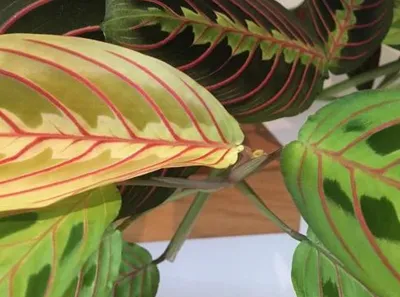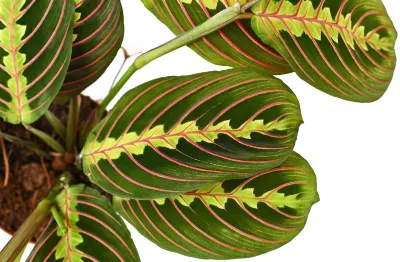Maranta Red Stripe, a cultivar of Maranta Leuconeura, is famous worldwide as a Prayer plant due to its distinctive postures during day and night. Prayer Plant belongs to Brazilian tropical rainforests and possesses extraordinary foliage distinguished by arc-shaped red veins and dark green velvety color around the midrib with fresh green color on the leaf’s margins. Moderately a slow-growing plant reaches up to one foot in height and can cheer up any house corner.

Prominent Family Members: Maranta Arundinacea, Maranta Kerchoveana, Maranta Leuconeura Lemon Lime, Maranta Leuconeura Silver Band
Essential Products
How do you take care of a Prayer Plant?
Prayer plant hails from Amazon rainforests and flourishes in high humidity and moderately warm temperatures. The plant needs a well-draining and moist potting mix and loves growing in bright, indirect light. We have further elaborated on all the aspects and requirements to take care of keeping your Prayer Plant thriving.

Why do they call it a Prayer plant?
Maranta Leuconeura Erythroneura is commonly known as the Prayer plant, as the leaves of the plant fold-up during the night depicting the movement of praying hands. Other members of the Marantaceae family, like Calatheas and Stromanthe, are also photoperiodic and respond to light changes.
Therefore, many people and even garden stores mistakenly refer to them as Prayer Plant, which is incorrect. Maranta Leuconeura Erythroneura or Maranta Red Stripe is the actual Prayer Plant.

Adding Maranta Leuconeura to your Houseplants
The most crucial point to consider while bringing a new plant home is to avoid the spread of disease and infestation in your garden. You must ensure that no pests or diseases are attacking the new plant. Please keep your new Prayer plant away from all other plants for around two weeks.
If there is any sign of diseases or pests, then use a fungicide or pesticide-related to the issue and add one week to the time out. When the time is over, carry out a thorough inspection of the plant, and then you can place it with all the other plants in your garden.
Beautiful foliage of the Prayer plant
You may notice drooping of the leaves of your Maranta Leuconeura, do not worry, as the plant is getting used to the new environment in your home.

What are the Light Requirements for Maranta Leuconeura?
The best place for your Prayer plant is near a window where it will get a sufficient amount of required diffused light. Keep in mind that they are shade lovers and can’t tolerate direct sun rays. If your plant’s beautiful foliage starts decoloring or fading, you have to change its place as the symptoms indicate the plant is getting intense direct sunlight.
If you plan to grow the Prayer Plant outdoors, provide it with proper shade or plant it in a shady area.

Humidity and Temperature Requirements
Maranta Leuconeura is migrated from the high humid region of the Brazilian rainforest and demands more than 50% humidity to remain healthy. The plant’s gorgeous leaves will become crisp, and the leave’s edges will turn brown if adequate moisture is not available.
An effective way to increase humidity is to use a plant humidifier or group all plants in a bright space. You may increase the humidity around Prayer Plant by placing it in a pebble tray containing water. Misting is another commonly used method for increasing humidity; however, always ensure removing water droplets from leaves; otherwise, fungal growth will start on leaves.
What temperature do Prayer plants like?
Prayer plants can’t survive in temperatures that are too hot or cold, and they enjoy living in temperatures ranging from 60-80°F. If the temperature goes under 55°F, the plant will stunt and eventually die if the situation persists.
The Maranta Fascinator plant does not cope well with sudden temperature changes. Therefore, you shall not place your plant near a heating/cooling vent to avoid exposure to varying temperature drifts.

How often should I water a Prayer plant?
Another vital thing to ensure is the amount of water given to the prayer plant. It would be best to ensure the soil is not too wet or too dry. Therefore, always check the soil moisture level before watering. You may use a soil moisture meter or your finger to check if the top two inches of the soil are dry.
Always use water at room temperature for watering and avoid tap water if it is high in minerals. Go for distilled, filtered, or rainwater if you want your plant to grow healthy.
Please ensure the pot drain hole is adequate and not blocked, so the excess water leaves instead of getting accumulated near the roots, causing root rot.

Soil requirement for Maranta Leuconeura
The Prayer Plant loves to sit in moist soil, which is slightly acidic (5.5-7 PH level). However, excessively wet or soggy soil can invite a fugal attack on roots. Therefore, the soil shall also be well-draining.
You may use the ready-made soil mix for African violet as it suits Prayer Plant requirements. On the other hand, you can make your pot soil in the home by mixing two parts common houseplant soil mix, one part peat moss, and one part perlite.

Pruning and Maintenance of Prayer Plant
The Prayer plant does not require frequent pruning and maintenance. You shall only remove the sick or diseased leaves to stop the spread of disease and divert the plant energy towards new growth. Always use a sterilized tool to prune the plant.
Besides pruning, occasional cleaning of leaves by wiping with a damp cloth will rejuvenate the plant’s looks and vigor. Furthermore, cleaning activity will also help reduce the chances of pests developing their colonies.

Fertilization requirements for Maranta Leuconeura
Fertilization is essential for the healthy growth of a plant; therefore, fertilize the Maranta Fascinator plant every 2-3 weeks during the growing season. The growing season expands from early summer to late summer.
You may use a balanced 2-2-2 houseplant fertilizer and apply as per the instructions. Please avoid over-fertilization as it can cause roots damage and burning of leaves.
Note: Remember to water your plant before fertilizing it.

Repotting of Maranta Prayer Plant
Prayer plants are moderately slow-growing; they need to repot once after two to three years. Repotting provides root balls more space to grow and absorb nutrients and water.
Follow these steps to repot your plant successfully.

Propagating Maranta Fascinator Tricolor
You can increase the number of your Prayer plants by propagating through root division which is an easy way to make new saplings from a healthy mother plant.
The number of baby plants will depend on the mother plant’s size, big plant, and more saplings.
Here we will explain the Maranta Fascinator plant propagation method.

Is Prayer plant toxic to humans or pets?
The Prayer plant is an entirely non-toxic plant and completely safe for humans and pets. Kids and pets can play around with the plant, and you shall not have any concerns.

Pests and Common Queries
Common Pests
Red Maranta Prayer Plant is rarely infected by pests, especially when kept indoors. However, the new addition of a plant from the nursery can bring several pests like Spider Mites, Whiteflies, Thrips, Scale, and Mealybugs. Moreover, Fungus Gnats love to lay eggs in moist soil, and if the infestation is severe, the larva can damage roots also.
Prayer plants are prone to attacks from spider mites, thrips, and mealybugs. A pest infection is a powdery substance on the leaves that causes the browning of leaves. You can manually remove the pests by wiping or using Neem oil, a natural insecticide. You may spray the plant with a pesticide if the infection is severe.
Why do my Prayer plants leave start curling inwards?
Curling leaves are a sign of underwater stress; therefore, hydrate the plant immediately with a filter or distilled water. As soon as the plant is hydrated, leaves will start uncurling.
Why are Prayer Plants’ leaves yellowing or wilting?
Overwatering or inadequate draining is the most probable reason for the yellowing of leaves. Please review your watering frequency considering the soil moisture levels to eliminate overwatering scenario.

Blocked pot drain holes can cause poor drainage. Therefore, please ensure the drain hole is not blocked. If the soil lacks draining properties, improve the soil draining capability by adding perlite or sand.
Why does my Prayer plant have brown tips?
It is a sign that a plant is present in a dry atmosphere; increase the humidity level by using the humidifier of place it with other plants to get enough humidity through Transpiration. In addition, a pot sitting on a pebbles-filled tray containing water in it is another good source to increase humidity around the plant.
Is a Prayer plant good for indoors?
The Prayer plant is an excellent indoor option as it is an entirely harmless plant and purifies the air. Furthermore, it is a low-spreading plant and does not require much living space.
Does a Prayer plant flower?
Prayer plants produce tiny white purplish blooms in the wild; however, it is scarce to find them flowering indoors.
Can I put a Prayer plant in the bathroom?
Yes, you can put Prayer Plant in a bathroom. Bathrooms are high humidity places, and the Prayer plant loves humidity. Please ensure the plant is placed away from direct sunlight exposure from a window.








